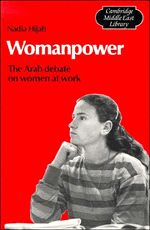Book contents
- Frontmatter
- Contents
- List of tables
- Preface
- List of abbreviations
- Introduction
- 1 The great family law debate
- 2 Cross-currents conservative and liberal
- 3 Arab women in the workforce
- 4 Jordanian women's liberating forces: inflation and labour migration
- 5 The Arab Gulf states: demand but no supply
- 6 Power past and future
- Bibliography
- Index
2 - Cross-currents conservative and liberal
Published online by Cambridge University Press: 01 June 2011
- Frontmatter
- Contents
- List of tables
- Preface
- List of abbreviations
- Introduction
- 1 The great family law debate
- 2 Cross-currents conservative and liberal
- 3 Arab women in the workforce
- 4 Jordanian women's liberating forces: inflation and labour migration
- 5 The Arab Gulf states: demand but no supply
- 6 Power past and future
- Bibliography
- Index
Summary
If we go back to the early days of Islam, we will find it was a real revolution. Why should I go against a real revolution?
Arab woman student wearing Islamic dressThe public debate on women's roles began in the nineteenth century, alongside the slow spread of formal schooling for boys and girls. It was conducted within the larger debate on reforming society as a whole in order to lift the Islamic world out of the centuries of stagnation that had afflicted it under Ottoman rule. With the growth of Turkish and Arab nationalism, the reformist debate gradually became more boundary-conscious.
The major issue for the reformists was how to reconcile the precepts of religion to the needs of the modern age. The great liberal Islamic reformists of the nineteenth century, such as Rifaa al-Tahtawi, Jamaleddin al-Afghani and Muhammad Abduh, believed that Islamic traditions had been corrupted over the centuries. A proper understanding of Islam's message would reconcile the demands of the modern age with the principles of faith. (For the best account of Arab thought in the nineteenth and early twentieth centuries see Hourani, 1983.) The need to resolve this question and to set about strengthening Arab society became more pressing as the nineteenth century wore on and the Arab world found itself an easy prey for Europe's growing appetite for new colonies.
- Type
- Chapter
- Information
- WomanpowerThe Arab Debate on Women at Work, pp. 38 - 62Publisher: Cambridge University PressPrint publication year: 1988

